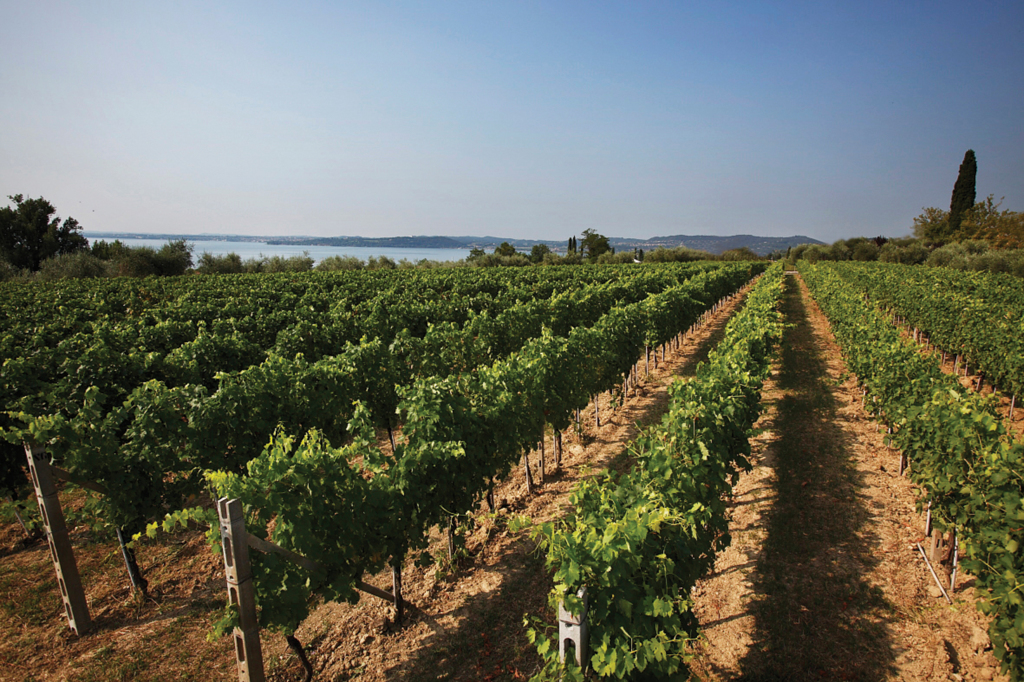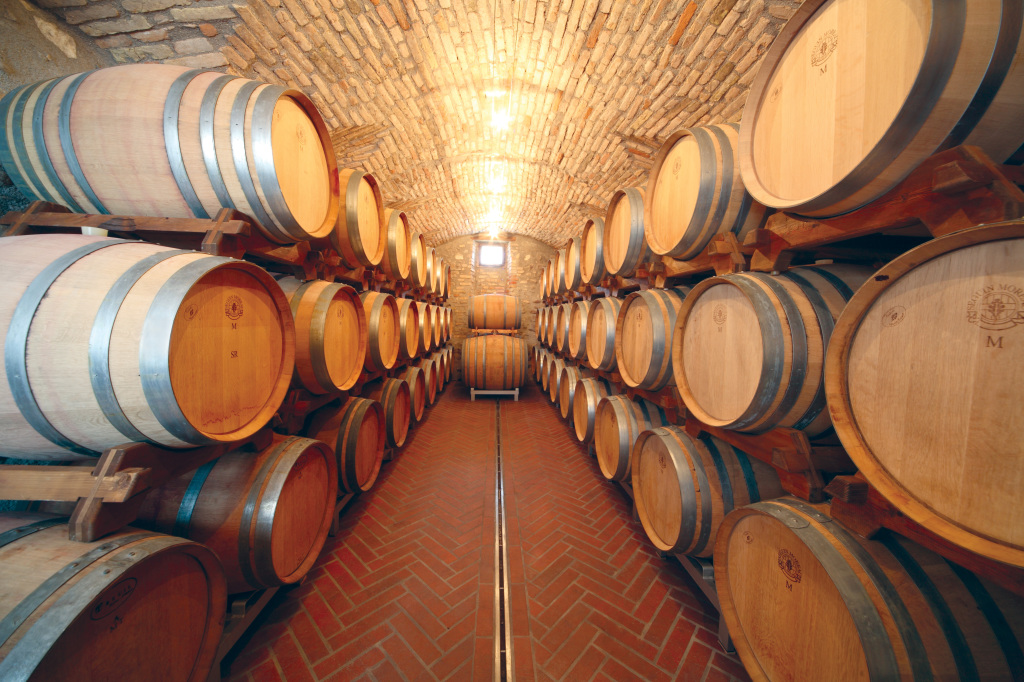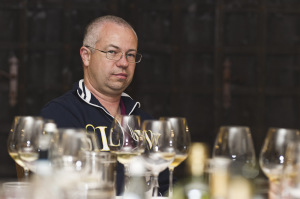 The ‘Lugana’ is a refined white wine, produced in the argillaceous soils in an enchanting location to the south of Garda Lake, between two regions: Lombardy and Veneto. The production area covers 5 municipalities: Desenzano, Lonato del Garda, Peschiera del Garda, Pozzolengo, and Sirmione. It benefits by the temperate micro-climate of the lake, which allows obtaining one of the most successful Italian wines. The Lugana is a structured white wine, characterized by a good longevity and a well recognizable aroma of wildflowers and citrus; it is obtained by processing a particular local variety of Trebbiano, the so-called ‘Turbiana’, an ancient and noble vine which can produce a white wine rich in nuances and personality. The ‘Consorzio di Lugana’, the local producers' Consortium, established in 1990, promotes and enhances the knowledge of this wine, both in Italy and abroad.
The ‘Lugana’ is a refined white wine, produced in the argillaceous soils in an enchanting location to the south of Garda Lake, between two regions: Lombardy and Veneto. The production area covers 5 municipalities: Desenzano, Lonato del Garda, Peschiera del Garda, Pozzolengo, and Sirmione. It benefits by the temperate micro-climate of the lake, which allows obtaining one of the most successful Italian wines. The Lugana is a structured white wine, characterized by a good longevity and a well recognizable aroma of wildflowers and citrus; it is obtained by processing a particular local variety of Trebbiano, the so-called ‘Turbiana’, an ancient and noble vine which can produce a white wine rich in nuances and personality. The ‘Consorzio di Lugana’, the local producers' Consortium, established in 1990, promotes and enhances the knowledge of this wine, both in Italy and abroad.
Five types of Lugana
The production specification includes five types of Lugana: the ‘Base’ Lugana, the ‘Superiore’, the ‘Riserva’, the ‘Vendemmia Tardiva’, and the ‘Spumante’.
The production of the ‘Base Lugana’ covers almost 90% of the DOC: it is characterized by a pale yellow colour with greenish reflections, delicate aromas which offer floral sensations mixed with notes of almond, and a gentle and defined taste.
The ‘Lugana Superiore’ has a more varied and complex profile: its colour shows more golden reflections; its more articulated scents offer sensations of wild herbs, ripe apple, and citrus fruits, combined with notes of hazelnut and spices; its flavour, more structured, is supported by a lively and tonic acidity and is crossed by a mineral flavour which gives a ‘salt’ nuance to the wine.
The natural evolution of the ‘Superiore’ is the ‘Lugana Riserva’: it is either aged or refined for at least 24 months, 6 of which in bottle. This wine is characterized by brighter chromatic tones, more advanced and complex scents, with smoky notes of flint and balsamic reflections, a warmer mineral taste, but it is also enveloping, savoury, and persistent.
These three wines differ for their permanence in cellar, too: the 'Base' version can remain there for 2-3 years, while both the ‘Superiore’ and the ‘Riserva’ have a developmental potential which can unfold along a decade.
 The ‘Vendemmia Tardiva’ is a different Lugana, a more experimental one, prepared with overripe grapes; its profile is softer and thicker, not excessively sweet, in which the sugar residue is balanced by its acidity.
The ‘Vendemmia Tardiva’ is a different Lugana, a more experimental one, prepared with overripe grapes; its profile is softer and thicker, not excessively sweet, in which the sugar residue is balanced by its acidity.
The ‘Spumante’ version represents a well-established tradition and is currently produced with both the Charmat or Martinotti, and the classical method. In the first case its organoleptic profile is marked by a greater simplicity and freshness, with primary aromas of citrus and a creamier and more generous perlage, while in the second one the profile becomes more refined and complex, with a more elegant and dynamic bouquet, as well as a more graceful and crisp perlage. These wines are realizing incredible records. Today the Lugana destines abroad 70% of its production and is by far the most exported wine from Lombardy. This success is obtained thanks to the quality of this unique product, but also to the skilful work of a Consortium which since 1997 has followed with constant care many promotional activities, allowing it to be known and appreciated all over the world.
 Then, we continue in this direction, planning training sessions for local businesses and DOC ones, organizing tastings, educational tours, promotional events, and participating in prestigious exhibitions concerning our sector. Our white wine is predominantly still and it is now sold worldwide; it places itself in a medium price range and is mainly marketed in the channel of restaurants, hotels, and wine shops, much less in large-scale retail trade, because of the number of produced bottles, amounting to 12 millions in 2013. Our production and the results of this wine are growing year after year, stimulated by a strong foreign demand, first of all from Germany: 35% of the quoted 70% of exports is destined for this Country. However, we do not intend to stop here, and for this reason we will continue our activities and invest in the USA and in new markets, including Poland, Denmark, Serbia, and the United Kingdom».
Then, we continue in this direction, planning training sessions for local businesses and DOC ones, organizing tastings, educational tours, promotional events, and participating in prestigious exhibitions concerning our sector. Our white wine is predominantly still and it is now sold worldwide; it places itself in a medium price range and is mainly marketed in the channel of restaurants, hotels, and wine shops, much less in large-scale retail trade, because of the number of produced bottles, amounting to 12 millions in 2013. Our production and the results of this wine are growing year after year, stimulated by a strong foreign demand, first of all from Germany: 35% of the quoted 70% of exports is destined for this Country. However, we do not intend to stop here, and for this reason we will continue our activities and invest in the USA and in new markets, including Poland, Denmark, Serbia, and the United Kingdom».